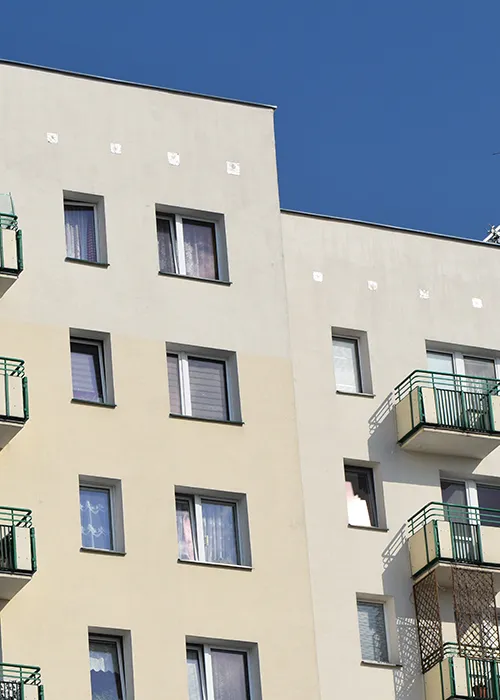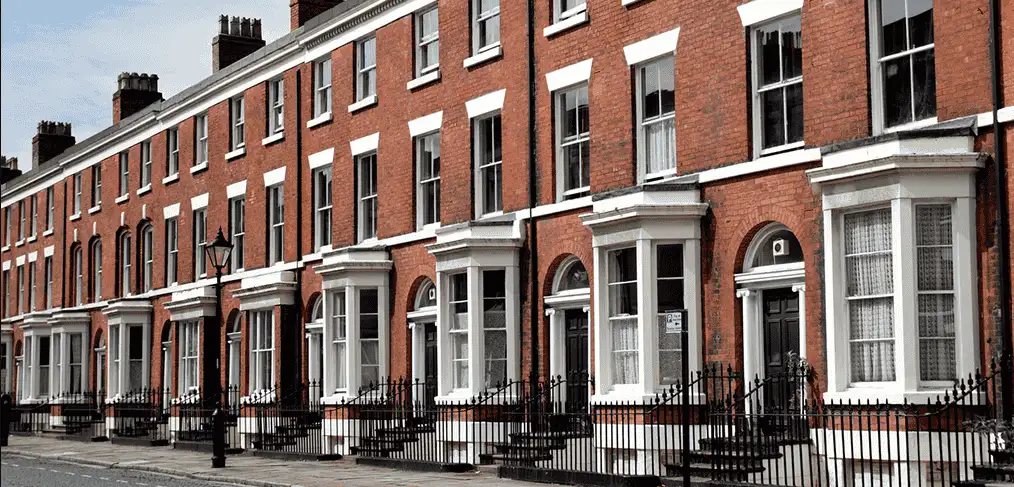
Concrete House Mortgage
Can you get a concrete house mortgage? Find out here. We go through when it’s easier and harder to secure this type of mortgage, lender requirements and more.
speak to a mortgage advisor
Fill out this form and we’ll contact you to book a free call with one of our mortgage experts.
"*" indicates required fields
A concrete house mortgage is a loan that is specifically for the purchase of a house made of concrete. Concrete homes are seen as non-conventional builds, meaning that they can be harder to finance, So you may need to discuss Non-Standard Construction mortgages with your broker. There are, however, a few things you can do to make it easier to get a mortgage on a concrete home. We discuss a few of those things in this article to help you maximise your chances of getting a mortgage on a concrete house.
We’ll also discuss the history of such builds, why they’re classed as non-conventional and what factors can affect your ability to get a mortgage on them.
Contents
What Are Concrete House and What Is the History Behind This Type of Build?

The first concrete homes were built in the 1950s as a solution to the housing crisis in the UK. After the Second World War, there was a massive need for affordable housing for returning soldiers and their families. In order to meet this demand, builders turned to precast reinforced concrete homes.
Unfortunately, by the 1980s, it became apparent that these homes were not as structurally sound as they were supposed to be. The steel reinforcement bars inside the concrete were slowly corroding, which led to a loss of structural integrity in many of these homes.
In response to this, mortgage lenders began limiting their lending on concrete properties. They raised their requirements for structural checks and increased the mortgage deposit that was needed.
Today, there are still many concrete homes in the UK. However, they are slowly being replaced by newer, more modern construction methods. Despite the challenges that come with them, concrete houses can be a great option for those looking for an affordable home. With proper maintenance and care, these homes can last for many years.
Why Is Getting a Mortgage on a Concrete House More Difficult?
The main reason that getting a mortgage on a concrete house is more difficult than other types of homes is because of the structural issues that can arise with concrete houses.
Because of the potential for these issues, many lenders require higher mortgage deposits and stricter property surveys for concrete homes. Additionally, because of the increased risk involved with lending on concrete homes, many lenders also charge higher interest rates for these types of mortgages. As a result, it can be more difficult and expensive to get a mortgage on a concrete house than on other types of homes.
However, there are still some lenders who are willing to provide mortgages for concrete homes, so it’s important to shop around and compare offers before making a decision. Ultimately, while getting a mortgage on a concrete house can be more difficult than other types of homes, it is still possible to find lenders who are willing to provide financing.
Can You Get a Mortgage on a Concrete House?

The short answer is yes, you can get a mortgage on a concrete house. However, it may be more difficult to find a lender who is willing to lend on these properties. As part of this, you may find that there’ll be a lower loan-to-value, meaning you may need to put down a larger deposit.
Many lenders are hesitant to lend on concrete homes due to the potential for structural problems. This means that you may need to put down a larger deposit or pay a higher interest rate.
You’ll also be required to get a structural survey before your mortgage can be approved. This is to ensure that the property is in good condition and that there are no major repairs needed.
If you’re thinking of buying a concrete house, it’s important to do your research and speak to a mortgage adviser to see what options are available to you. With the right loan, you can make your concrete house purchase a reality.
Why Are Non-Standard Concrete Homes More Expensive to Mortgage?
One of the main reasons that non-standard concrete properties are more expensive to mortgage is because they are often seen as a higher risk. This is because these types of properties can sometimes be difficult to repair or may even need to be completely rebuilt.
This increased risk means that lenders will often require a higher mortgage deposit from borrowers. It may also be more difficult to obtain a mortgage on a non-standard concrete property if the borrower does not have a repair plan in place. Finally, lenders may also charge a higher interest rate on mortgages for these types of properties.
It’s also worth noting that non-standard concrete properties tend to be more difficult to insure, which can add to the overall cost of owning one of these types of properties.
All of these factors can make non-standard concrete properties more expensive to mortgage. However, there are some ways to offset these costs, such as using an independent mortgage supplier to find the best mortgage deals or by carrying out repair work before applying for a mortgage. If any structural work does need to be made, for the lender to feel comfortable to lend on the property, the work will need to be carried out via a bridge.
What Factors Can Affect Your Eligibility for a Concrete-Built House Mortgage?
Your ability to get a mortgage on a concrete house can be impacted by many different factors, including:
-
- The deposit: most mortgage lenders require a larger deposit for a concrete house to reduce their LTV (loan-to-value), mitigating their risk
- The type of property: the majority of non-standard construction mortgage lenders will give you mortgages with income multiples of around 4
- Your credit history: bad credit can make it more difficult to get a mortgage on a normal property, let alone a non-standard one. If you’re approved, be prepared to put down a larger deposit and pay a higher interest rate
- Other factors: the type of house – e.g. semi-detached or detached – the location, the certification or warranties of any work that’s been carried out on the property, can also affect your eligibility
A specialist mortgage broker can help you navigate the process of getting a mortgage on a concrete house. They’ll be able to assess your situation and find mortgage lenders who are willing to work with you.
How Can I Find Mortgage Lenders for Concrete Houses?
When it comes to finding a mortgage lender for a concrete house, you’ll need to seek a specialist non-standard construction mortgage lender. This means they focus on lending for properties that are not built using traditional methods – such as brick and mortar.
To find mortgage lenders for concrete houses, you can start by researching lenders who specialise in financing properties with non-traditional construction methods or materials. Look for lenders with experience in providing mortgages for concrete houses or other types of unconventional construction. You can search online, consult with mortgage brokers like John Charcol, or ask for recommendations from real estate agents or professionals in the construction industry.
Additionally, consider reaching out directly to lenders to inquire about their mortgage products and criteria for financing concrete houses. Be prepared to provide details about the property, such as its construction type, location, and any relevant documentation or certifications. By conducting thorough research and exploring your options, you can identify mortgage lenders who are willing to finance concrete houses and find the best mortgage solution for your needs.
Top of Form
The good news is that John Charcol can provide independent mortgage expertise and help you find the right mortgage for your needs. We have a wealth of experience in dealing with non-standard construction mortgages and can help you find a loan that meets your circumstances.
If you’re looking for a concrete house mortgage, we can help.
As we’re an independent mortgage broker, we can bring a whole market of mortgages to you. We search the entire market to find you the best mortgage that for your needs. We have access to a wide range of specialist mortgages and lending solutions – such as bridging loans, so we’re confident that we can find the right loan for you. Get in touch with us on 0808 303 5553 to find out more.
Is it Hard to Sell a Concrete House?
Selling a concrete house is not necessarily hard, but it can come with a few challenges that are worth understanding. These types of homes are known for their durability, energy efficiency and resistance to pests, which can be appealing to many buyers. However, some people may be unfamiliar with concrete construction or hold misconceptions about it being cold or industrial in appearance.
The ease of selling a concrete house often depends on how well the property has been maintained, its location and how it compares to other homes in the area. If the design is attractive and the house has been kept in good condition, there is no reason why it should not sell just as easily as a traditional brick or timber-framed home. It can also help if the benefits of the concrete structure are clearly highlighted to potential buyers.
Types of Concrete Construction Methods and Mortgageability

There are a few different types of concrete construction methods and each one can impact your ability to get a mortgage.
The most common type of concrete construction is poured concrete. This is when concrete is mixed and then poured into moulds on-site. This method is typically used for larger projects, such as commercial buildings or apartment complexes. A poured concrete house mortgage is generally the easiest to obtain, as it tends to be the most mortgageable type of concrete construction.
Another common type of concrete construction is precast concrete (PRC). This is when concrete is cast into moulds off-site, then brought to the construction site to be assembled. This method is often used for smaller projects, such as houses. Precast concrete can be more difficult to finance than poured concrete, as there is a higher risk that the concrete will not cure properly and will develop cracks.
Finally, a Wimpey no-fines construction is a type of precast concrete construction that was popular in the UK after World War II. This method involves using small pieces of aggregate instead of sand, which makes the concrete much lighter. Wimpey no-fines construction is generally more difficult to finance than other types of concrete construction, as there is a higher risk that the concrete will not cure properly and will develop cracks.
A Wimpey no-fines mortgage is a type of mortgage specifically for concrete homes that were built using the Wimpey no-fines construction method. While these types of homes can be more difficult to finance, there are still some lenders who are willing to provide mortgages for them. To get a Wimpey no-fines mortgage, you’ll likely need to have a higher mortgage deposit and may be required to pay a higher interest rate. Getting in touch with a specialist mortgage broker, like John Charcol, means we can help you find the best deals for the most complicated circumstances.
Can I Get a Mortgage on a Concrete-Built House Depending on Who Built It?
The type of concrete construction used to build your prospective house can impact your ability to get a mortgage. Several widely known building companies specialise in concrete construction and each one has its own construction method. As a result, it is important to know which company built your house and what type of concrete construction they used to determine the mortgageability of the property. Here are some of the most common companies and their methods of construction:
Woolaway Construction Builds
Woolaway Construction was a post-War builder that constructed prefabricated housing with concrete frames and panels instead of steel. The majority of Woolaway’s construction were 2 storey semi-detached or detached bungalows, although they also erected several terraced 2 storey houses.
To get concrete construction house mortgages for Woolaway builds, you’ll need to verify whether it has a PRC certificate of Completion, demonstrating that it has been upgraded with standard cavity walls following the officially approved procedure.
Hawksley Constructions
Hawksley Constructions built PRC houses, which are generally constructed similarly to normal bricks, so you should have no trouble obtaining a loan for them. However, these houses contain prefabricated reinforced concrete beams and, although obtaining a mortgage for them might be challenging, it is by no means impossible — as long as you can show that you have a valid repair plan.
Whitson-Fairhurst PRC Homes
Whitson-Fairhurst homes were a major player in the development of prefabricated reinforced concrete housing as an expedient solution to the housing crisis. These residences are more common in Scotland and, as for other types of PRC homes, you’ll need to show that you have a valid repair plan to obtain a mortgage.
Airey House Constructions
Another builder in the post-World War II era’s low-income housing scarcity was Airey House Constructions. The homes were prefabricated concrete pillars, reinforced with metal tubing that may have come from military vehicles. PRC Airey house constructions were founded by Sir Edwin Airey.
It’s usually difficult to obtain a mortgage on an unrefurbished Airey PRC property. You’ll need to demonstrate that you have a repair plan in place, as well as the means to finance it. The lender will also likely require a higher mortgage deposit.
Reema Construction Homes
Reema construction was founded in the 1960s by Reema construction homes, which is still active today. There are 2 primary techniques: Reema Hollow Panel and Reema Conclad. Although mortgage lenders may consider Reema Conclad to be less of a risk, it is still difficult to obtain a mortgage for either type of home.
Orlit Concrete Houses
The Orlit houses were a design created by Erwin Katona for many residences in the United Kingdom. The Orlit houses were post-War homes that were meant to be inexpensive to manufacture and quick to construct. They appeared to be the ideal match for the era’s housing shortage.
Getting a mortgage on an Orlit concrete house will be difficult and most of these buildings have already been destroyed. If you want to obtain a mortgage on an Orlit concrete home, you’ll need a larger deposit contribution and will need to do some repair work before the lender will offer you a loan.
Wates Group PRC Builds
The Wates Group PRC houses were developed to meet the affordable housing need after WWII and are extremely difficult to mortgage because they are riddled with corrosion problems which damage the concrete and steel employed in the homes. The Wates group PRC buildings have even been dubbed “defective housing.”
Cornish Units
Cornish units are a form of prefabricated reinforced construction that is particularly well-known in Cornwall and the neighbouring areas. Cornish was created following World War II. Type 1 Cornish units will most likely have PRC panel walls on the ground floor and a mansard roof with almost vertically clad tiles over timber trusses on the second floor. Type 2 Cornish units will have pre-cast reinforced concrete external walls on both stories.
The majority of Cornish properties with brick walls to the ground floor have, in most cases, been reconstructed to a decent standard and can be mortgaged with ease. However, those with concrete panels still in place are more difficult to mortgage.
How Long Do Concrete Homes Typically Last?
Concrete homes typically have a long lifespan, often lasting for several decades to centuries with proper maintenance and care. Concrete is a durable and resilient construction material that can withstand various environmental conditions, including severe weather, fire, and pests. Additionally, concrete homes require minimal upkeep compared to other construction materials, reducing the need for frequent repairs or replacements. With regular maintenance and occasional repairs as needed, concrete homes can provide reliable and long-lasting shelter for occupants for many years.
Concrete houses may survive for up to 50 years without requiring structural repairs, but there have been occasions where concrete homes have only lasted for 20 – 30 years due to the methods or materials used. Concrete homes in the United Kingdom have sometimes outlasted 100 years, so long as they have been well-maintained.
This is why a mortgage lender will want to see evidence of a repair plan, as well as the means to finance it. Without this, it is unlikely that you’ll be able to get a loan for a concrete house, as the mortgage may outlast the house.
The Bottom Line
When considering whether to purchase a concrete home, it’s important to weigh the benefits of durability and longevity against any potential drawbacks such as cost or design limitations. Concrete homes are known for their strength and resilience, offering protection against severe weather, fire, and pests. With minimal upkeep requirements, concrete homes can provide reliable shelter for occupants over many years. However, prospective buyers should also consider factors such as construction costs, availability of financing, and personal preferences regarding architectural style and design. Ultimately, the decision to purchase a concrete home depends on individual circumstances, priorities, and preferences.
You can, however, maximise your chances by having a repair plan in place, using an independent mortgage broker like John Charcol and going for a type of build that is considered lower risk. For all your concrete house mortgage needs, be sure to contact us on 0808 303 5553. Our experts have access to a wide range of specialist mortgage products and our experienced brokers will be able to help find the right financing solution for you.
Related Articles
Get in touch with our experts
Book an appointment with an adviser today and we’ll help you work out which mortgage deal is best for you and your requirements.
